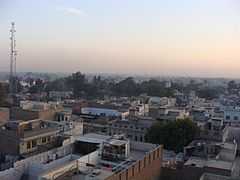Haroonabad, Bahawalnagar
| Haroonabad | |
|---|---|
 | |
 Haroonabad | |
| Coordinates: 29°37′N 73°07′E / 29.61°N 73.12°ECoordinates: 29°37′N 73°07′E / 29.61°N 73.12°E | |
| Country |
|
| Province | Punjab |
| District | Bahawalnagar District |
| Area | |
| • Total | 772 km2 (298 sq mi) |
| Elevation | 178 m (584 ft) |
| Population (1998) | |
| • Total | 0.36 M |
| • Estimate (2006) | 0.5 M |
| • Density | 366/km2 (950/sq mi) |
| Time zone | PST (UTC+5) |
| Number of Union councils | 1 |
Haroonabad or Harunabad (Punjabi, Urdu: ہارون آباد) is a town in Bahawalnagar District of the Punjab Province of Pakistan. The town is the headquarters of Haroonabad Tehsil and administrative subdivision of the district.Pre partition it was mainly of a mixed diversity of muslims and sikhs. [1] Punjabi is the local language.
History
Haroonabad was established in 1920's and was named after one of the sons of Nawab of Bahawalpur, as it was a new town in the State of Bahawalpur. It is widely known that old name of Haroonabad used to be "Badru Wala" (Urdu: بدرُو والا)
The city of Haroonabad is located on the edge of the Cholistan desert in southern Punjab province, close to the Indian border. In 1998 the population was 63,000 and apart from the small-scale seasonal, cotton-related industrial activities such as washing and ginning (separation of seeds and fibre), there was no major industry in the town.
Administration
Haroonabad consists of 22 Unions which are mostly villages. The only noticeable sub-urban town is Faqirwali apart from Haroonabad city's own unions.[2]
Economy
The economy is based around agriculture, cotton being of major importance, followed by cauliflower.[3] The headquarters of two national brands of tea are also here, Vital Tea and Prime Tea. Wastewater is not used for irrigation.[4]
Climate
The climate of Haroonabad is hot and humid. The temperature extremes occur during the months of May, June, and July, when the temperature reaches up to 49–53°C. In August, the monsoon seasons starts, with heavy rainfall throughout the area. December and January are the coldest months, when temperatures can drop down to –1 °C.
The annual average rainfall is 160 mm.
Language
Punjabi is the main language of the region. Majhi and Malwi dialects of Punjabi are commonly spoken by the locals.Bagri is another language spoken in Haroonabad. Bagri is a dialect of Rajasthani language and is commonly spoken in most parts of Haryana, Rajasthan, and adjacent areas along southeast border of Indo-Pak Punjab. Characterized by high, level and low lexical tones Bagri has 65% lexical similarity with Haryanvi. From Punjab to Rajasthan Haryanvi and Bagri can be considered transitional languages from Punjabi language to Rajasthani language.
Notable landmarks

- Jamia Mosque
- Government Boys High School
- Railway Station Building
- Municipal Committee Building
- Office of the Market Committee
- Govt. Rizvia Islamai Degree College
- Vital city
- THQ Hospital
Notable personalities
- Muhammad Ijaz-ul-Haq, MNA and ex-minister
- Chaudhary Abdul Ghafoor MNA ex-Law Minister
- Senator Zafar Iqbal Chaudhary MPA
- Wajid Ali Abbasi (Islam Baan Store)
- Hafiz Gulam Muhyudin' (professor Arabic )(phd scholar)'
Abdul Khaliq
Gallery
-

In The Railway Ground.
-

Main Bazaar of the city, decorarted on 12th Rabi-ul-Awwal.
-

Jamia Masjid in the center of Haroonabad.
References
- ↑ Tehsils & Unions in the District of Bahawalnagar - Government of Pakistan
- ↑ Unions in Bahawalnagar District - National Reconstruction Bureau
- ↑ Ensink, Jeroen (ed.), "The Cases of Haroonabad and Faisalabad", Wastewater Use in Pakistan, Patancheru, India: International Water Management Institute (IWMI), retrieved 2008-01-17
- ↑ Feenstra, Sabiena; Hussain, Raheela; van der Hoek, Wim, eds. (October 2000), "Health Risks of Irrigation with Untreated Urban Wastewater in the Southern Pubjab,", Proc. Institute of Public Health, Pakistan (PDF), Lahore, Pakistan: IWMI, p. 19, retrieved 2008-01-17
External links
- Haroonabad's News and Fun Portal
- Geo Haroonabad News Network
- Haroonabad News dot com
- Haroonabad's Website
| Wikimedia Commons has media related to Haroonabad tehsil. |